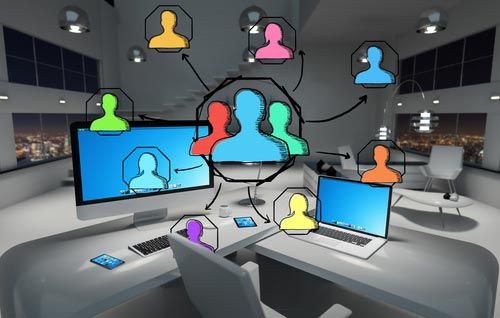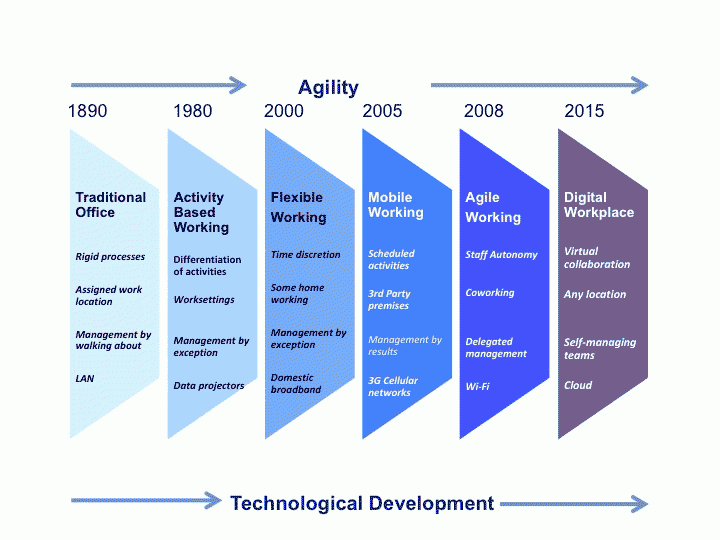
The term the “Digital Workplace” is still relatively new and has been gaining traction around 2013. The concept of the Digital Workplace is still emerging, and it is likely to continue to do so for some time. So what exactly is the Digital Workplace? Its least ambitious definition is as a synonym for a portal, or an intranet. However Gartner describes it as “an ongoing, deliberate approach to delivering a more consumer-like computing environment that is better able to facilitate innovative and flexible working practices.” This definition legitimises the Digital Workplace as an enabler of a new way of working. Put simply, it is s a unified workplace where technology based solutions and tools allow employees to be productive, creative, and engaged at any time, in any place.
An effective Digital Workplace will have a symbiotic effect of providing an enjoyable place for employees to work while providing productivity gains for organisations that employ them. Digital Workplaces provides employees with the freedom and flexibility to do their jobs in the best way available, wherever they are working. Furthermore as David Dunbar states “It should to be a pleasant place to work allow people to perform at their best while maintaining their work/life balance. The digital workplace, like a good physical one, should be somewhere that you want to work.”
Digital Workplace or Digital Workspace?
Digital Workplace is often described as an extension of the physical workplace by furniture providers, workplace designers and architects. But they have a vested interest as providers of furniture and physical facilities in talking about a place of work. The new generations of workers are unlikely to accept the idea of working in confined physical spaces, however attractively furnished. As my colleague, Paul Allsopp, of the Agile Organisation says “these days it’s all about screens not desks”. Not every employee has a desk but most have access to a screen on at last one device.
Paul Miller, CEO and founder of the Digital Workplace Group, describes the digital workplace as, “the technology-enabled space where work happens - the virtual, digital equivalent of the physical workplace.” To differentiate the technology from the broader Digital Workplace term, this is sometimes known as the Digital Workspace. It is the term I choose to use in the Ways of Working Progression Model which seek to show the evolution of new ways of working.

The technologies enabling Digital Workspaces
Employees are empowered to do their best work when technology effectively supports their role. The digital workspace isn’t just a single platform or tool such as Office 365. Deloitte’s has a more technological based definition: “The digital workplace encompasses all the technologies people use to get work done in today’s workplace... It ranges from your HR applications and core business applications to e-mail, instant messaging and enterprise social media tools and virtual meeting tools.”
The power of today’s technology means that the aspiration that people can work from anywhere, anytime can now be realized, While technology of the Digital Workspace enables people to work anywhere, Digital Workspaces need set out to balance freedom of choice with security ensuring secure, remote access to business information and applications.
Technology has evolved to support an increasingly connected digital world exploiting newly available technologies such as the Cloud. With cloud storage files and data can be readily shared between team members, and modified using collaborative tools. For example, Unified Communications and collaboration services can bring together all fixed, mobile and desktop communications services in one integrated platform that is accessible from any device.
As the systems and data are migrated to the Cloud, the IT department has an evolving role no longer a focussing on infrastructure, but rather on delivering the required role-based applications, data and services through browser-based dashboards.
The Digital Workspace is also driving a change in management of employees. While Agile Working has focused on the autonomy of the individual, the Digital Workplace reflects today’s social media based world and is focussed on connecting people together electronically enabling virtual collaborations. Management responsibility is being devolved to teams, (as it is in Agile software development) breaking down the hierarchies that have been existed since traditional office working.

